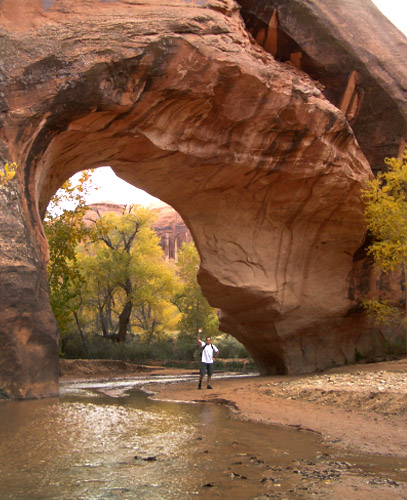
– Coyote Bridge –
Coyote Gulch is THE classic Escalante canyon and thus deservedly also the most popular. A year-round stream flowing down through an entrenched canyon cascading over multiple waterfalls makes it a main draw in warmer months. Multiple impressive natural spans, evidence of a previous civilization and ample great camping spots make it popular almost year round. Probably in part due to the popularity, it is now REQUIRED to carry and use WAG BAGS for doing your business in the canyon (even though there are two pit toilets located in the mid-section of the canyon.)
One can hike down canyon and into Upper Coyote Gulch by setting out via the Red Well TH or the Hurricane Wash TH both along the Hole-in-the-Rock Road. Alternately one can begin in Lower Coyote Gulch which can be accessed via the Crack-in-the-Wall TH at the end Forty Mile Ridge Road or via longer thru-hike routes like the Hayduke Trail. A final option is to park at the Water Tank about 2/3 of the way out Forty Mile Ridge Road and either go cross-country to mid-Hurricane Wash or use the scramble route to mid-canyon near Jacob Hamblin Arch (not recommended for beginners or anyone afraid of heights/falling!)
Here is my description headed DOWN the canyon via Hurricane Wash. Or, if you plan to hike it in the other direction, click here to view the alternate description for those going UP Coyote Gulch.
Hurricane Wash to The Junction
From the TH the route enters the wash and heads downcanyon. There might be a minor seep here, but it will likely dry up fast. (NOTE: if thru-hiking and you really need water, there is a tank near the cabin just a few hundred yards north of the parking area.)
The canyon is fairly wide open in the beginning, but after a few hours it becomes somewhat entrenched. The sand/stone-filled wash is NOT a very fun walk and definitely one you want to avoid mid-day in the summer if at all possible. Just remember, these first miles are the price of admission for the great canyon ahead.
About 1.5 hrs into the hike, the landscape changes drastically as water appears and the canyon springs to life. The Navajo sandstone walls quickly become taller and taller and before too much longer one is at the confluence with Coyote Gulch To the left (upstream) is the alternate route to this point via Red Well. A short side-hike up this direction will take one to the scenic side canyon known as Sleepy Hollow.
- Forty Mile Ridge Road
- Above Hurricane Wash
- Cobble-stone walk
- Narrow section in Hurricane Wash
- Water begins to flow
- Hurricane Wash meets Coyote Gulch
Hurricane Junction to Coyote Bridge
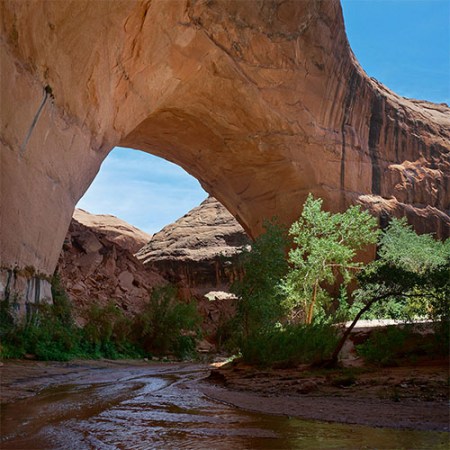
Jacob Hamblin Arch (aka Lobo Arch)
Continuing downstream one quickly enters the heart of the canyon. The alcove undercuts formed by the meandering stream are incredible and arguably the best of any on the Colorado Plateau (those in Lower Muley Twist are a close second in my book.)
After a few of the bends one arrives at the spectacle that is Jacob Hamblin Arch (originally named Lobo Arch). You’ll need a wide-angle lens to take it all in via camera. One can climb up and through the arch, but don’t short-cut it entirely and miss the undercut just south of the arch which is probably the best of the best (and a popular camping area.) The fin which reaches down to this spot provides an adventurous exit to the north. Though non-technical, this route includes extreme exposure so a rope is suggested and climbing experience mandatory.
Immediately downcanyon and still within view of the arch is another popular camping spot. There is a pit toilet on the southern wall in this section. This is also the spot where another steep route comes down from the rim, this time on the southern side providing access to Forty Mile Ridge Road. This route is not as daunting as the one on the northern rim, however it too is not for the faint of heart and experience scrambling on slickrock is strongly suggested.
NOTE: this entire stretch of the canyon is incredible scenic, but also incredibly crowded at times. On my 2018 I passed through on a weekend in May and counted 50 people camping within this 1/4 mile stretch!
After another narrow section one comes to a favorite spot for photographers — Swiss Cheese Falls. That’s not an official name and I think it would be hard pressed to really consider this a waterfall, but it’s definitely a photogenic spot none-the-less.
Just around the next bend is what I call ‘The Notch‘ — a place where the stream cuts a short slot through the sandstone fin of a meander. At times one can simply walk right through this spot in ankle-deep water. At other times it can be chest deep! If progress is blocked for any reason, there is a well-worn bypass trail around the meander to the south.
One more bend downcanyon and one arrives at Coyote Bridge. In many cases this has become the symbol of this iconic canyon. One walks right under the bridge and can enjoy the different, yet both beautifully unique, views from each side. There is a good camping spot immediately adjacent to the bridge on the downstream side, however I would suggest not camping there unless it’s already late in evening and you plan on an early start. IMHO it’s a bummer to arrive at an iconic backcountry spot only to find someone’s tent(s) perched right in front!
- Upper Coyote Gulch
- Nice Bends
- Under an Overhang
- Jacob Hamblin Arch (aka Lobo Arch)
- HDR of Jacob Hamblin Arch
- Giant Undercut — climbers’ route up
- Undercut south of JH Arch
- Jacob Hamblin Arch from downstream
- The pit toilet (you don’t want to see it open!)
- Access to semi-sketchy route up
- Semi-sketchy route up to Forty Mile Ridge Road
- Swiss Cheese Falls
- Swiss Cheese Falls | Coyote Gulch ⮞⮞⮞
- Swiss Cheese Falls | Coyote Gulch ⮞⮞⮞
- Swiss Cheese Falls | Coyote Gulch ⮞⮞⮞
- The ‘Notch’
- The ‘Notch’ from downstream
- Coyote Bridge from upstream
- Below Coyote Bridge in Fall
- Coyote Bridge from downstream | Coyote Gulch ⮞⮞⮞
Coyote Bridge to Cliff Arch

Pictographs
Continuing downcanyon from Coyote Bridge, there will be several hanging alcoves on the northern side of the canyon. Some of these include relics of a past civilization. The second one in particular has a good set of pictographs if you are willing to climb up to them. Remember, please don’t touch as the oils from our skin breaks down and destroys this ancient art.
Just below the pictograph panel is a side canyon which enters from the north. A brushy, splintered side-trail leads one back to what author Steve Allen calls The Black Pool in his guidebook. It’s an amazing pool underneath a mossy overhang.
Just down canyon a few bends one can find the “Green Pool” hidden in the shadows and the brush on the right side.Then it’s less than another mile downstream to where the canyon turns south around another meander. Instead of following the stream, it’s possible to exit on the north side and climb up to the saddle of the fin. This is an excellent shortcut and provides an up-close view of Cliff Arch as well as the next section of canyon including the first of several waterfalls. Whether you’ve used the short-cut or the meander, take care is getting back down to stream level below the waterfall. There are several use-trails which descend questionable spots. If in doubt, take your time and explore — there’s always a fairly easy way to be found.
- Mid-Coyote Gulch with fall colors
- Hanging Alcove with Pictorgraphs
- Pictographs | Coyote Gulch ⮞⮞⮞
- Indian Relics
- The Black Pool | Coyote Gulch ⮞⮞⮞
- The “Green Pool”
- Purple wildflowers and yucca in bloom
- Cliff Arch from the short-cut trail
- Close up on Cliff Arch
- View from Above Coyote Gulch
- Same spot in Autumn
- Zoom to the Upper Waterfall
The Waterfall Section

Upper Falls
The next section of the canyon is dominated by five waterfalls. The first falls which I’ll refer to as Upper Falls sits below Cliff Arch and is the tallest along the main route at about 12′. It tends to be a favorite with photographers.
Another bend downcanyon is another great waterfall. This one leaps about 9′ over the top of a flared sandstone ledge. Use a bypass on the right (LDC – looking down canyon) to get past the drop and below the waterfall. The cottonwood trees in the background make for a gorgeous scene here in autumn.
Continuing downcanyon one soon arrives at the next waterfall — which falls/slides down about 10′ over a rounded sandstone outcrop. This is probably the trickiest fall to get below as it requires a short scramble down the rockwall. There are several places to do this, but the easiest is down from the falls around the bend near a tree on the right side (LDC).
Just ahead is another fall pouring in from a spring high above on the northern wall of the canyon. It doesn’t have as much volume as the falls in the main watercourse, but it’s still a spectacle to behold as the 30′ drop often fills the air with a fine mist of water. Thus I often call it “Mist Falls“.
Around the next bend is an awesome undercut alcove which makes for an incredible group camping spot if you are fortunate to get there before others. The area is so popular that there is another pit toilet nearby uphill on the northern side of the canyon.
Just below the alcove and pit toilet is the final waterfall. It’s more of a cascade really as the streams dances down a sloping incline of exfoliating slickrock. It’s easy to walk down right beside the cascade at this point.
- Upper Falls
- Upper Falls
- Second Falls | Coyote Gulch ⮞⮞⮞
- Second Falls
- Third Falls
- Third Falls | Coyote Gulch ⮞⮞⮞
- “Mist Falls “
- “Mist Falls” | Coyote Gulch ⮞⮞⮞
- Undercut Alcove
- Undercut Alcove
- Lower Pit Toilet
- Lower Falls/Cascade | Coyote Gulch ⮞⮞⮞
Lower Coyote Gulch
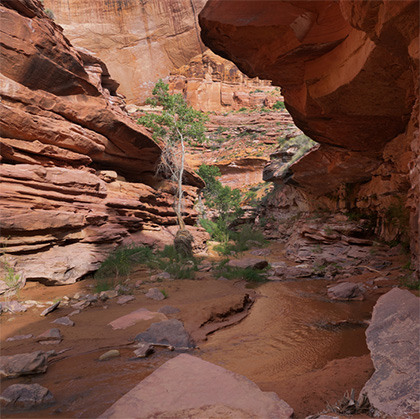
Lower Coyote Gulch
Below the final waterfall/cascade, the canyon becomes more entrenched and begins to take on a different feel. Signs of floods rushing through the canyon are evident and serve as a reminder one needs to always be aware of current weather conditions (especially those upstream).
After a short narrow/rocky section the canyon opens up a bit and one can see Stevens Arch high on the skyline in the distance. Near this area are a few cottonwood trees on the left side of the stream (LDC) and a good camp spot. This is also the location where an alternate route exits the canyon on the northern side and climbs up and follows the Kayenta rock ledges downcanyon to a dramatic view across from the arch as well a less-used route down to the Escalante River via a side canyon to the north. One can read more about this route on the Stevens Arch page.
Remaining in Coyote Gulch one continues through a rocky section and will soon notice a well-worn route up a sand dune on the right. This is the trail up to the Crack-in-the-Wall exit route which leads to the TH at the end of the Forty Mile Ridge Road.
Immediately downcanyon there is a rock/log-jam which one must bypass. There are several ways to do this, but IMHO the best route is immediately on the right (LDC) by traversing a sloping slickrock ramp back down to stream. This method involves a bit of exposure which may give some pause (especially if sandy or traversing in wet/slick shoes.) Alternate routes climb higher, but all involve a a tricky spot or two. Those comfortable with walking on slickrock may pass this point without even noticing.

looking down scary ledge
In the very lower end of Coyote Gulch the stream passes towering streaked walls before somewhat unceremoniously ending at the Escalante River. Congratulations — you’ve completed one of the best hikes around! However, don’t turn around here, definitely walk up river for the great views from beneath Stevens Arch. It’s possible to make a loop back with the alternate route described above. If time permits, one should even explore the bottom end of Stevens Canyon or even climb up inside Steven Arch.
- Lower Coyote Gulch evidence of flood
- entrenched Lower Coyote Gulch
- camp near access to Stevens Arch Route
- above Lower Coyote Gulch
- Rockfall in Lower Coyote Gulch
- Coyote Gulch ends at Escalante River
- Escalante flows below Stevens Arch
- streaked walls along the Escalante
- below Stevens Arch
- Stevens Arch Alternate Route
- Route to Stevens Arch Viewpoint
- Across from Stevens Arch
- The Dune seen from Stevens Arch Route
- Route through dune to Crack-in-the-Wall
- View down from Crack-in-the-Wall
- Navigating the Crack-in-the-Wall Exit
Video Reference:
Important Waypoints:
- N37.3855° W-111.1324° — Hurricane Wash TH
- 37.4065° -111.0867° — Approximate Exit/Entrance Route to The Water Tank TH
- 37.4204° -111.0581° — Junction of Hurricane Wash and Coyote Gulch
- 37.4191° -111.0432° — Jacob Hamblin Arch (aka Lobo Arch)
- 37.4152° -111.0335° — Swiss Cheese Falls
- 37.4163° -111.0277° — Coyote Bridge
- 37.4175° -111.0212° — The Black Pool
- 37.4196° -111.0076° — Cliff Arch
- 37.4261° -110.9913° — Access to Stevens Arch Route
- 37.4283° -110.9876° — Access to Crack-in-the-Wall Route
- 37.4276° -110.9808° — Coyote Gulch ends at the Escalante River
Discover more from Across Utah!
Subscribe to get the latest posts sent to your email.















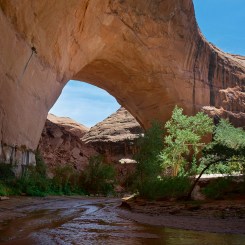

















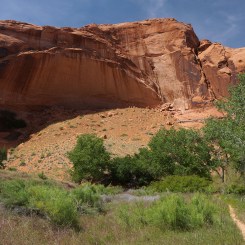



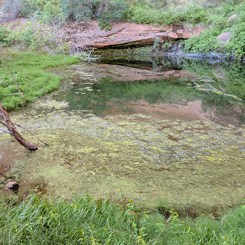

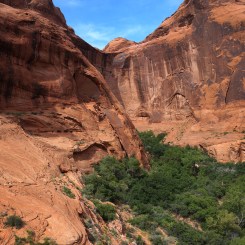


























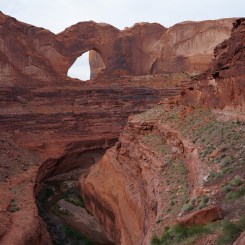







We’ll be going there in a month for a few days and we can’t wait. How do you store your food? We’re from Colorado and we need to hang it for Bear reasons (in the RMNP you need a bear canister).
Not a major issue, though sometimes the packrats, or more rarely ringtails, can be persistent. Wire mesh bags are available as a solution. Or… I actually sleep with my food in the tent — something that is definitely NOT recommended in bear country.
Jamal
Is there anything technical about the hurricane wash to water tanks TH shortcut? How difficult is this exit route to find? Also, have you ever gone up the crack in the wall? Is there anything that requires climbing skills?
I am going with a group,of very strong hikers who have no climbing experience. I don’t want to lead them out of their comfort zone. Thanks for all the info and your videos.
Paul
Nope — nothing technical on either end. Crack in the Wall is a tight squeeze and a bit of a scramble, but not hard and no exposure. Lowering packs down with a 15′ rope will make it easier. The route out/in from Hurricane Wash to the Water Tank is more or less just a matter of finding the path of least resistance. There some steep slickrock out there, so if it gets too sketchy — just look for a better way.
Awesome post! I got a buddy who is a bit scared of heights. Do you have any good recommended routes that might be okay for backpacking/camping to get to the gulch?
There’s no problem if you enter from the top via Hurricane Wash or Red Well. Even the Crack-in-the-Wall Route isn’t really bad at all.
Jammer – approximate coordinates for the Alcove Zone in Sleepy Hollow? Much appreciated.
Hmm… not sure about coordinates, but I’d say about 1/2 mile up from the junction with Coyote. About another 1/2 mile past that is the end of the route for hikers in Sleepy Hollow at a dryfall.
Nice pics & blog post! -Alicia @ http://www.girlonahike.com
Nice post Jamal, I enjoyed reading it!
I’mailed a Pennsylvanian living vicariously through your experiences! Thank you for your documentaries and the effort that goes into them before, during and after the trip.
Jamal,
We love everything you send out. It brings back without fail so many memories, and we want to get back as soon as we can. Thanks also for all your wonderfully edited videos.
Great post as always! Thanks for all the info – especially the waypoints! Looks like a pain to post.